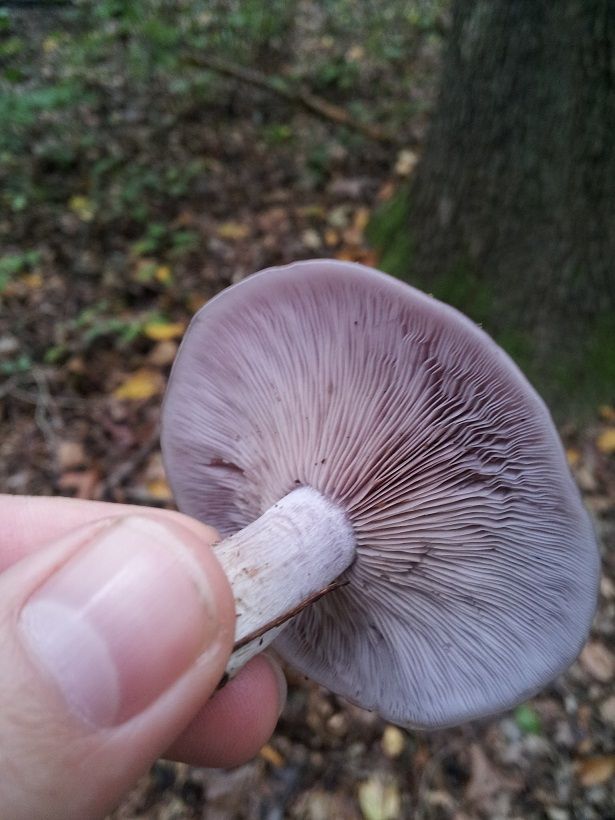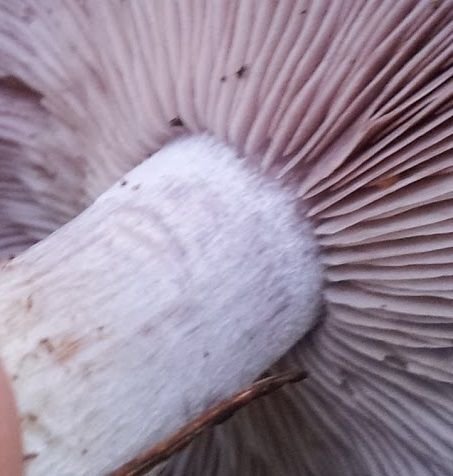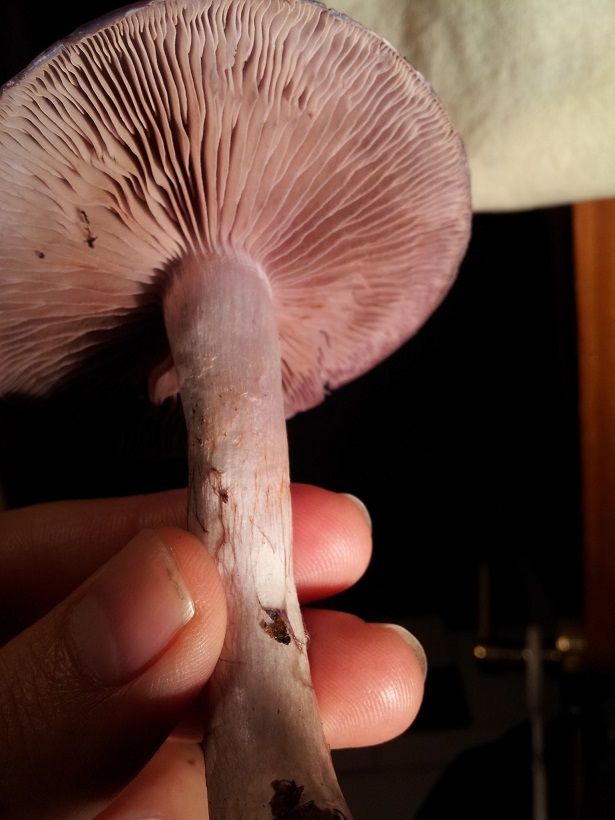
There are a hell of a lot of mushrooms on the planet and identifying them isn't always easy. Some mushrooms have such obvious characteristics that they seem to scream at you, even from a great distance. Take the Laetiporus genus, which will almost always be a bright orange, sometimes yellowish, shelf mushroom that only grows on wood, usually the side or bottom of a tree

When you're walking through a forest and see a Laetiporus, 9/10 times, you're going to know it immediately. There might be some question of the exact species of Laetiporus it is, but you're going into the situation with a pretty good overall idea. This one is a Laetiporus sulphureus.
Most fungi are referred to by their capitalized Genus name - e.g. Laetiporus - followed by their lowercase species name - e.g. sulphureus. This is the official way to name them, but the most popular mushrooms have nicknames. Laetiporus sulphureus is commonly nicknamed "Chicken of the Woods" or "Sulphur Shelf."
Now lets take a much more difficult example.

What kind of mushroom is that? A purple one...? There is no way to just look at this mushroom and draw any definitive conclusions about what kind of mushroom it is.
This is where mushroom identification becomes really important. Looking at this mushroom at first glance, you may just see a small purple mushroom. But there are several other traits which help us to identify it.
Look at the photo again. See the slight, light brown coloration on the cap? And see how a piece of detritus seems to be stuck to the cap. It means the cap, at some point, was a bit sticky. But it doesn't look slimy. Also, the mushroom is near a piece of wood, but seems to be growing next to it in the dirt and leaves. These are all important macro characteristics to consider. (A "macro" characteristic is just one that is not "micro" characteristic and can be seen with the naked eye.)
Let's pick this mushroom up and take a closer look.

Now look at the mushroom, and then at the picture at the top of this post. Which kind of mushroom cap do you think this looks closest to?
.
.
.
.
.
.
.
.
.
.
.
.
.
.
.
.
.
.
.
.
.
.
.
Personally, I think its slightly convex. But you probably noticed that it was either flat or convex.
Now let's flip it over and look underneath.

What do we you see here? First, you need to find out what kind of spore bearing surface is under the cap. Take a look at the photo and compare it to the picture on top again. Then scroll down when you have the answer.
.
.
.
.
.
.
.
.
.
.
.
.
.
.
.
.
.
.
.
.
.
.
.
.
.
.
.
.
.
.
This mushroom has gills. Excellent.
Lets take a closer look at where the gills meet the stem.

Now compare this close up with the picture up top and see if you can identify what kind of gill attachment this mushroom has. There are a lot of options up there, but don't worry about finding the exact gill attachment, just try to see which ones clearly DO NOT apply to this mushroom
.
.
.
.
.
.
.
.
.
.
.
.
.
.
.
.
.
.
.
.
.
.
.
.
.
.
.
That might have been harder, but looking at the photo I think you probably saw that the gills were not decurrent or sub decurrent. It looks to me like they are some mix of emarginate, seceding and sinuate. But the exact answer isn't as important with gill attachment as other things, except to notice the gills are not running down the stem and are a bit detached. This is a little bit of a trick question, but I want to begin fostering your eye for details.
Let's take one more look at the underside

What other macro characteristics do you notice? The gills are purple and densely packed. The stem has slightly whiter purpler striations moving vertically down its length.
If you were actually in the forest, you would go ahead and smell the mushroom. If you smelled this mushroom, as I did, it would smell strongly mushroomy and almost sweet - very pleasant.
At this point, we know a lot more about this mushroom:
- Grows on dirt
- Purple cap with slight hint of brown
- Cap was once sticky, now dry.
- Purple, densely packed gills, not decurrent (running down the stem)
- Slightly convex cap.
- Light striations of color in thick stem.
- Pleasant, sweetish mushroomy odor.
- And, you wouldn't know this, but found around NYC.
There are a whole bunch of other things to take into account, but for now this will do.
The way to use all this information is to take it to a mushroom key.
Mycokey.org has a great one Here
When running things through the mycokey, if you aren't sure about something, leave it blank. Go ahead and try it, just putting in the characteristics you are sure about - like gills, cap shape, approximate colors and where it was growing, stuff like that.
Go do it now.
If you only filled in the stuff you are very sure about, you should end up with about a dozen possible mushrooms. How do you narrow that down?
Remember in The Mushroomer #2, we talked about how mushrooms are really just penises? Well, one big measurement we need to take is the color of the mushrooms spores.
The simplest way to do that is to put the mushroom on a piece of glass, spore surface down, and cover it, leaving it for several hours. You can use any transparent piece of glass, like a pyrex measuring cup for instance. You can also use black or white paper, but glass is more ideal to see the colors.
When you return, most mushrooms will leave beneath them on the glass a collection of spores called a "Spore Print."

That mushroom on the right is the same mushroom we've been looking at this whole time. As it got older, it lost it's purple color and became pale pink. The beautiful print beside it is a light cream pink color. Now, go back to the mycokey.org key and insert this final detail.
And, BOOM, you should have that 12 mushroom list fall down to just two - Lepista nuda and Entoloma euchrome.
Click on each option and compare them and it should be obvious to you which one is the mushroom we've been looking at.
**Lepista nuda, a.k.a the Blewit!
The Blewit is a mushroom often sought after as a prime edible by knowledgeable foragers. However, before you just bend over and eat a blewit - something I am not suggesting you or anyone else do, even after you think you've identified it successfully, you need to go through the motions of identifying it as completely as possible. Why? Well take a look at this mushroom.

This is not a blewit, this is a mushroom from the genus Cortinarius.
But at a glance, on the forest floor, especially in a drizzle, this mushroom could easily be misidentified as a blewit. However, if you do the work we just went through with the blewit, then not only will you know it is not the same mushroom, but the differences will be obvious.
Here are some more pictures of the Cortinarius. Try to go through the same process we went through above with the Blewit and then run the details you are 100% sure about into the mycokey.org key.

If you've taken accurate observations you should get all Cortinarious options as a result. The spore print is centrally important!
Why does the distinction between a blewit and a Cortinarious matter so much?
Because where blewits are delicious, safe mushrooms to eat, Cortinarious mushrooms are almost universally poisonous, sometimes even deadly. Almost all Cortinarious mushrooms are filled with the mytotoxin Orellanine, which, if left untreated can kill you several days after you eat the mushroom.
This is why I can never recommend you eat the mushrooms you find, even if you're pretty sure of their species - not only for the sake of my own liability, but for your safety - because even experienced mushroom hunters make these kinds of mistakes, with terrible results. .
That, all of that, is your basic introduction to the identification of mushrooms. It is a fulfilling and complex activity, and filled with endless variety. If you learn this skill, you will be able to apply it all over the world. I have found and identified mushrooms on four continents and it doesn't get old.
If you ever find a mushroom you can't identify, google mycology and your area. There are awesome online resources for budding mycologists, with the subreddit mycology being a great starting point for any inquiries.
But in the future, if you find a mushroom, take some pictures showing all the details and post it in the comments section of these posts! We can work together to try to identify them!
This has been a super long post, and fairly complicated. I don't expect you to have absorbed it all - we haven't even touched on several important characteristics which will come up when needed later. I don't even expect this post to get a lot of upvotes or attention.
My goal in this post is to make a key for you all to refer back to, and for newcomers to the Mushroomer to get the lay of the land. I will link to this post in every future Mushroomer post and sometimes refer back to it.
With that, we have finished the introduction to mushrooms and mycology. Next post, we will start talking about specific mushrooms and their many strange, beautiful and, sometimes, psychedelic, effects.
DBER
This is perfect. It makes me want to go out tomorrow morning and forage mushrooms. Great references and identification techniques.
Downvoting a post can decrease pending rewards and make it less visible. Common reasons:
Submit
I agree. I don't even eat mushrooms, but this would be fun. Kinda like metal detecting, but above ground. lol
Downvoting a post can decrease pending rewards and make it less visible. Common reasons:
Submit
For users - I put the wrong link to the mycokey key - that one is for agarics only.
This is the starting link
http://www.mycokey.com/newMycoKeySite/MycoKeyIdentQuick.html
Downvoting a post can decrease pending rewards and make it less visible. Common reasons:
Submit
uper informative! I used to go mushroom hunting with my uncle as a child-he got so much knowledge bout mushrooms...all that I still know is that all sponge like underside mushrooms are edible and that one that looks like a coral (white or cream color) with the other I am not sure so I leave them..but your article gives me courage to venture out and try again :) thanks
Downvoting a post can decrease pending rewards and make it less visible. Common reasons:
Submit
I would trust your uncles knowledge of the local fauna more than a generalized book personally. In a broader sense, he's not entirely wrong about all the sponge underside mushrooms - there isn't one I know of which can really kill you. Having said that, some might certainly give you gastrointestinal trouble.
The corals are really cool, right? They are, as far as I know, also not poisonous, though I've never eaten one. But I've also never found one that wasn't either old or surrounded by dog poop by chance.
I do hope it encourages you to explore fungi - I am very conservative on safety though, and so I personally always says identify but don't eat.
Downvoting a post can decrease pending rewards and make it less visible. Common reasons:
Submit
Yes you are right bout the "sponge" ones, but see the most of them found here are the really good ones-unfortunately I dont know their names in english but I do in german :)-anyways the " coral" looking ones are called Krause Glucke which means roughly translated curly broody hen lol and its a very tasty mushroom! the spongy ones we used to collect and ate fried in butter with a little flour coating or we would cut them up and dry them for soups and stews during the winter months-by the way those are sold here for as high as 40 Euros per kilogram (little less than 2 lbs) for fresh and a lots more for dried ones! My uncle would pickle some small type of mushroom also sweet/sour-delishous :) happy mushroom hunting :)
Downvoting a post can decrease pending rewards and make it less visible. Common reasons:
Submit
This is so helpful, thanks for sharing!! I wish I could resteem!
Downvoting a post can decrease pending rewards and make it less visible. Common reasons:
Submit
I'm glad you found it helpful!
It really is just the basic starting point - the rabbit hole goes very very deep and in greater detail then I even indulge in (I don't even talk about microscopy or DNA testing!). Plus, I realized after there were some things I wish I'd changed and some thing I wished I'd added.
But, the basic premise of what the process is like is here, and it is a fun process. Lots of much more qualified books available if you want to really get in depth - and often there are mycological societies or groups in local neighborhoods as well.
Downvoting a post can decrease pending rewards and make it less visible. Common reasons:
Submit
I have a bunch of books already, but I think I need to take the time and go on foraging hunts with our mycological society. I feel like I learn so much more if I have someone show me (like you just did!) then trying to make sense of it from a book :)
Downvoting a post can decrease pending rewards and make it less visible. Common reasons:
Submit
Excellent information, walk-through and resource guide. Very helpful indeed! Definitely earned my follow and I look forward to reading your other posts relating to mycology.
Downvoting a post can decrease pending rewards and make it less visible. Common reasons:
Submit